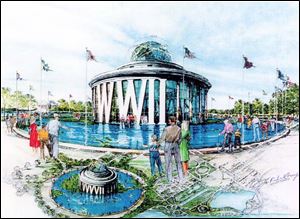
Veteran wants to add personal touch to memorial
10/11/2006
Richard Berry has been working on this design of a memorial.
The National World War II Memorial in Washington features a wall with 4,000 stars commemorating the 400,000 Americans who died in battle.
The "Freedom Wall," as it's called, is surrounded by 56 stone pillars, which stand for the unity our nation showed during those trying times.
Richard Berry, an 85-year-old Perrysburg resident who fought in the war, doesn't believe the monument in Washington does enough to honor those who died fighting for this country.
"It's just a bunch of big stones," Mr. Berry said. "There's nothing personal about it."
Mr. Berry, a 1939 graduate of Perrysburg High School who served on navy boats in 1944-45 and fought in the Battle of Iwo Jima, has designed a WW II memorial and museum he wants built in Perrysburg or Perrysburg Township. He said he has more than 15 years of monument design experience, and has submitted a drawing for the Korean War Memorial located outside the Wood County Courthouse.
Mr. Berry said his vision for a WW II memorial would do justice to all those who lost their lives in that war, much like the Vietnam War Memorial has done for Vietnam vets.
"What's more important than the history of the men who fought and died in the war?"he asked. "All of my buddies who died over there get what? A fraction of a gold star? Museums are supposed to be more personal."
Elements of Mr. Berry's design, which he said he began working on 10 years ago, appear heartwarming and ambitious.
His museum is in the shape of a globe atop a map of the world. On the concrete map outside the building, Mr. Berry said families can purchase small squares with the name of a loved one who was killed in WW II and have it placed in the country where the person died.
Planned for inside the structure are large computer screens where families could access the name and battle histories of veterans, both living and deceased.
Feasible or not, he has also drawn a concrete dome inside the museum's outer glass structure to provide safety in case of a terrorist attack on this area.
The cost for such a project is incalculable, especially when considering that there are some portions of the design for the memorial - such as the number of floors - that are unfinished.
The National WW II Museum in New Orleans, which Mr. Berry said is more personal than the monument in Washington and is similar to what he's trying to accomplish, cost $31.5 million.
Funding for the New Orleans Museum was secured through contributions from federal, State of Louisiana, corporate, and private contributions, according to the museum's Web site.
Mr. Berry believes that he could raise more than $1 million by charging $20 for the squares, but he admits that he also would need to secure some funding from local, state, or federal government programs.
He said he has discussed his project with area politicians, but neither Perrysburg Mayor Nelson Evans nor township Board of Trustees Chairmen Robert Mack had ever heard of the idea.
"We don't have room for line items like that in our budget," Mr. Mack said. "I'm not saying it's not a good idea. Wwe just don't have the resources for something like that."
Mr. Berry said the only positive feedback is from Congressman Paul Gillmor (R., Tiffin), who urged him to contact local government officials.
Mr. Gillmor's office confirmed Mr. Gillmor did respond to a letter Mr. Berry wrote to him in July of 2002.
"We're talking about the Greatest Generation here, so there isn't any reason to oppose the idea," said Bradley Mascho, a spokesman for Mr. Gillmor. "Funding is the issue."
Said Mr. Berry: "I just want to get this built for the 400,000 of my buddies who died."